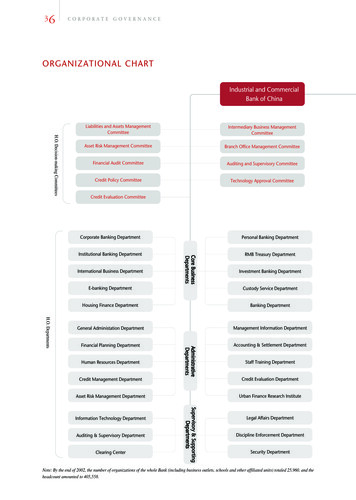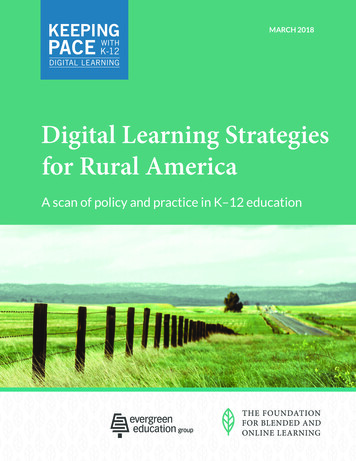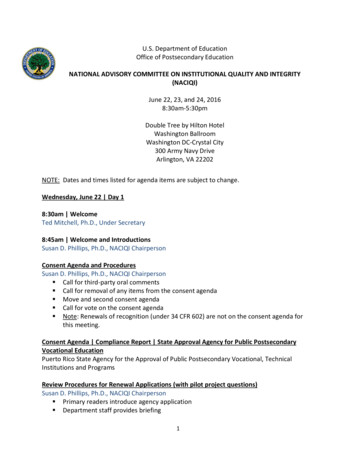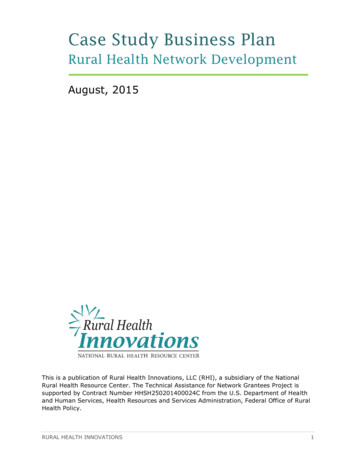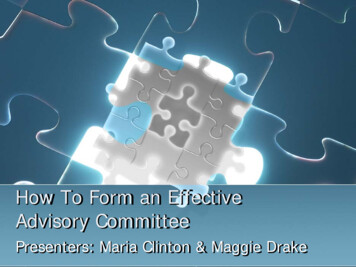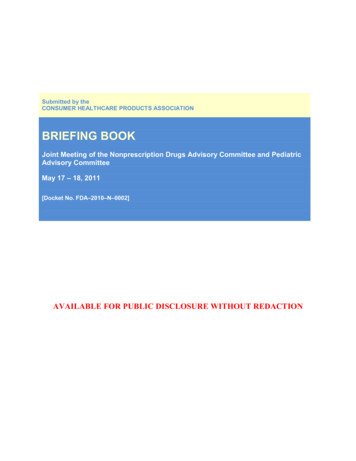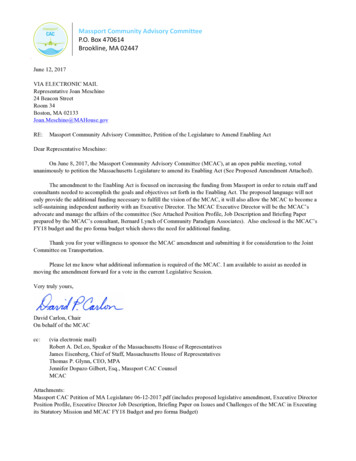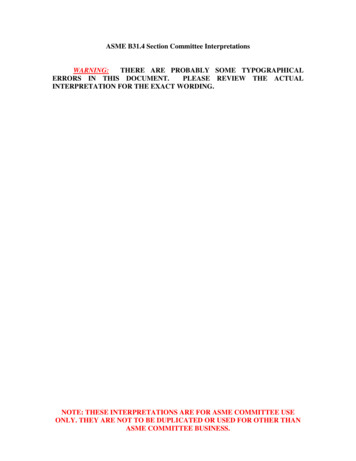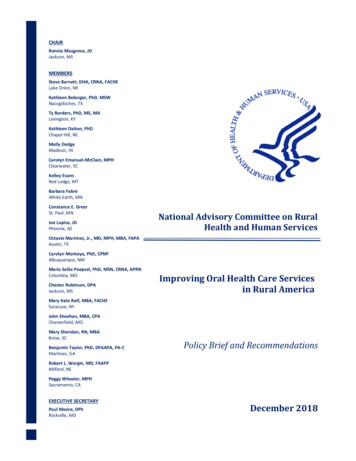
Transcription
CHAIRRonnie Musgrove, JDJackson, MSMEMBERSSteve Barnett, DHA, CRNA, FACHELake Orion, MIKathleen Belanger, PhD, MSWNacogdoches, TXTy Borders, PhD, MS, MALexington, KYKathleen Dalton, PhDChapel Hill, NCMolly DodgeMadison, INCarolyn Emanuel-McClain, MPHClearwater, SCKelley EvansRed Lodge, MTBarbara FabreWhite Earth, MNConstance E. GreerSt. Paul, MNJoe Lupica, JDPhoenix, AZNational Advisory Committee on RuralHealth and Human ServicesOctavio Martinez, Jr., MD, MPH, MBA, FAPAAustin, TXCarolyn Montoya, PhD, CPNPAlbuquerque, NMMaria Sallie Poepsel, PhD, MSN, CRNA, APRNColumbia, MOChester Robinson, DPAJackson, MSImproving Oral Health Care Servicesin Rural AmericaMary Kate Rolf, MBA, FACHESyracuse, NYJohn Sheehan, MBA, CPAChesterfield, MOMary Sheridan, RN, MBABoise, IDBenjamin Taylor, PhD, DFAAPA, PA-CMartinez, GAPolicy Brief and RecommendationsRobert L. Wergin, MD, FAAFPMilford, NEPeggy Wheeler, MPHSacramento, CAEXECUTIVE SECRETARYPaul Moore, DPhRockville, MD December 2018
National Advisory Committee on Rural Health and Human ServicesEDITORIAL NOTEIn September 2018, the National Advisory Committee on Rural Health and Human Services (hereinafterreferred to as “the Committee”) met in Charlotte, North Carolina. During this meeting, the Committeefocused on ways to improve the quality of and access to rural oral health care services. While in Charlotte,the Committee heard from federal and state health and human service officials and visited localstakeholders in Winnsboro, South Carolina, to discuss the challenges of providing oral health services torural communities. Information on the Winnsboro site visit is provided in Appendix A.ACKNOWLEDGEMENTSThe Committee expresses their gratitude to those who attended the stakeholder meeting in Winnsboro—especially our hosts, Winnsboro Smiles Dentistry—for sharing their experiences as oral healthpractitioners in rural communities. The Committee appreciates the research and policy backgroundprovided by Marcia Brand (DentaQuest Foundation), Normandy Brangan (Health Resources and ServicesAdministration—Federal Office of Rural Health Policy), Jennifer Holtzman (Health Resources and ServicesAdministration—Bureau of Health Workforce), Amy Martin (Medical University of South Carolina), andJocelyn Richgels (Rural Policy Research Institute). We would also like to acknowledge Taylor Zabel fordrafting this brief and for his work on behalf of the committee.TERMINOLOGYCraniofacial Complex: the oral, dental, and other tissues that house the organs of taste, vision, hearing,and smellDental Caries: Commonly called “cavities” or “tooth decay”; a progressive destruction of the toothcaused by infectionEdentulous: Lacking teeth; toothlessOral Cavity: Composed of the teeth and gums, their supporting connective tissues, ligaments, and bone,the hard and soft palate, the mucosal tissue lining the mouth and throat, the tongue, lips, salivaryglands, chewing muscles, and the upper and lower jaws connected to the skull by thetemporomandibular jointPeriodontal: Relating to or affecting the structures surrounding and supporting the teeth (e.g. gums)December 2018 Policy BriefPage 1 of 19
Improving Oral Health Care Services in Rural AmericaRECOMMENDATIONS1.2.3.4.5.The Committee recommends the Secretary consider the development of a rural dentalpractice capital grant program that would be contingent upon the provision of services toMedicaid recipients in rural and underserved areas.The Committee recommends HHS support a research study to assess rural Head Startgrantees’ ability to ensure that qualified oral health professionals screen enrolled children,develop a treatment plan, and follow the treatment plan to completion.The Committee recommends HHS support a research study to examine opioid prescribingpatterns for dental pain in rural and urban areas.The Committee recommends HHS support research studies to examine differences in theutilization and scope of insurance coverage for dental services among Medicare Advantageenrollees in rural versus urban areas.The Committee recommends the Secretary charge the Oral Health Coordinating Committeeto focus on rural oral health issues and to develop an action plan on improving rural oralhealth.INTRODUCTIONSince the Committee last researched the status of rural oral health care in the United States in 2004, oralhealth has persisted as one of the greatest unmet needs of rural Americans. 1,2 While some progress hasbeen made in this area, challenges remain, so the Committee is revisiting this issue. Approximately 34million Americans reside in rural or partially rural areas that have been designated by the US HealthResources and Services Administration (HRSA) as dental Health Professional Shortage Areas (HPSAs). 3Although a significant body of research links oral health to general health and well-being, it has arguablybeen given a lower priority in policy and in health literacy initiatives compared to other health issues. Oralhealth has also historically been separated both from the medical healthcare system, and oral healthprofessionals have usually been trained in separate locations and reimbursed by insurance independentfrom standard health plans. The separation of care—coupled with poor oral health literacy and a shortageof dental care professionals in rural areas—makes improving access to rural oral health care an importantissue for the Department of Health and Human Services.BACKGROUNDBiological Components of Oral HealthThe two most commonly recognized conditions related to oral health are dental caries and periodontaldiseases. They remain as two of the most common chronic diseases in the world; consequently, theSurgeon General’s report on oral health in 2000 listed them as a “silent epidemic” affecting our nation. 4The high prevalence of dental caries and periodontal disease—which has affected 91 percent of Americanadults at some point in their lives—indicates that these largely preventable conditions are not beingadequately prioritized in health policy and health systems. 5,6 This lack of priority is concerning when oneconsiders that oral health affects much more than the oral cavity.December 2018 Policy BriefPage 2 of 19
National Advisory Committee on Rural Health and Human ServicesThe Link between Oral Health and Overall Health and Well-beingThe oral cavity acts as more than just a window to conditions that would not otherwise be visible to thenaked eye; it is an integral part of a quality life. If left untreated, poor oral health can create or exacerbateoverall health complications. One well-known example to gain national attention was the death ofDeamonte Driver, a child whose tooth infection turned fatal after the bacteria causing the infectiontravelled to his brain. More common forms of mortality related to oral health include the nearly 30,000annual cases of oral and pharyngeal cancers, where approximately 7,500 of those cases result in death.5Untreated oral health conditions are also associated with increased incidence of stroke, coronary heartdisease, asthma, diabetes, and Alzheimer’s Disease. 7,8,9,10 Beyond clinical diseases and disorders, poor oralhealth may inhibit the ability to speak, smile, smell, taste, touch, and effectively convey emotions. Studieshave shown that poor oral health can reduce overall quality of life, self-worth, and the ability to receiveand retain a job. 11,12Current Approaches to Mitigate Poor Oral Health OutcomesWhile a number of the challenges the Committee identified in its 2004 report remain, there have beensome areas of progress. For example, expanded use of silver diamine fluoride has helped address dentalcaries issues in a less invasive manner. Expanded use of telehealth and the movement of some statestoward the use of dental therapists have also been positive developments. Preventive interventions havealso been stressed as an avenue to combat poor oral health outcomes, notably through the Institute ofMedicine’s 2011 report, Advancing Oral Health in America. These interventions include the use of fluoridein community water, dental sealants, and the utilization of community-based programs, usually througheducational systems.5Drinking fluoridated water has been shown to reduce dental caries by 25 percent in both children andadults. The CDC Division of Oral Health notes that community water fluoridation is one of the most costeffective methods to disperse fluoride to a population independent of age, race/ethnicity, orsocioeconomic status. The estimated individual return on investment for community water fluoridation(including productivity losses) has been found to range from 28.70 in small communities of 5,000 peopleor less, to 35.90 in large communities of 200,000 people or more. 13 While the value of fluoridation iswell-established, initiatives in more-sparsely populated regions of the country possess greater challenges,especially when there is no access to community water systems (e.g. individuals connected to individualwell-water systems).Dental sealants prevent caries from developing in the pits and fissures of teeth, where caries are mostlikely to form. A dental sealant is a thin layer of plastic resin or glass that inhibits stray food particles andbacteria from creating the ideal environment for the formation of dental caries. A literature review ofsealant studies found that resin-based sealants were effective 24 months after application at reducing theprevalence of caries by 85 percent; similar results were found four years after the application of sealants. 14Sealants can be applied in a dental office or in a community-based program, such as programs providedat a school or church. Many sealant programs target high-risk populations because they can be applied ina single setting and demonstrate both reduction of dental caries and overall cost savings for dental care.2December 2018 Policy BriefPage 3 of 19
Improving Oral Health Care Services in Rural AmericaBarriers to Oral Health Care in Rural AmericaChallenges in providing oral health care in rural America are associated with several well-documentedfactors. The following themes were highlighted during the Committee’s discussions in Charlotte andWinnsboro. Many of these issues were noted in the Committee’s 2004 report and deserve repeating in2018;1 they have been included in this list with issues not previously considered by the Committee: Geographic isolation Lack of adequate transportation Higher rate of poverty compared to metro areas Large elderly population (with limited insurance coverage of oral health services) Acute provider shortages State-by-state variability in scope of practice Difficulty finding providers willing to treat Medicaid patients Lack of fluoridated community water Poor oral health educationAccess to dental providers is one of the most common factors cited as a cause of rural oral healthdisparities. The shortage of practicing dental professionals in rural communities is influenced by a varietyof factors such as an unwillingness of dental care providers to work in rural regions, specialization in dentalcare, the capital needed to start a rural practice, and a large number of dentists predicted to retire in thenear future—issues that mirror the shortage of medical practitioners in rural communities. 15,16,17 In 2018,only eleven percent of practicing dentists serve rural or partially-rural communities, and over 5700 newdentists would need to serve these communities to remove their Dental Health Professional ShortageArea designation, as shown in Table 1.3,18 Even when a dentist practices in a dental HPSA, they are notobligated to serve Medicaid or CHIP-eligible patients, which further discourages those rural residents whodisproportionally rely on these insurance programs. 19 This creates challenges for serving vulnerablepopulations. For example, children enrolled in Head Start programs are required to receive oral healthscreenings and treatment from an oral health professional. A shortage of dentists in rural and tribalregions of the country places greater challenges on rural Head Start programs to meet this requirement.Table 1: HRSA’s FY18 Third Quarter report on Dental Health Professional Shortage Areas3Percentage ofPopulation ofDental PractitionersRural/Non-ruralNumber ofallDesignatedNeeded to 07%38,7637Partially RuralUnknownDecember 2018 Policy BriefPage 4 of 19
National Advisory Committee on Rural Health and Human ServicesDental therapists, defined as “expanded-function dental hygienists or other mid-level providers,” havebeen approved to practice in some states to address this dental professional shortage; however, the scopeof practice for these practitioners varies widely from state to state, as shown in Figure 1, which waspublished by the Oral Health Workforce Research Center. 20 The variation from state to state can be tracedto the effectiveness of legal, legislative, and media-based advocacy for dental therapists, as traditionaldentists and their associations have expressed concern and opposition to these new providers on issuesrelated to patient safety and quality. 21,22,23 Outside of the traditional dental community, there are alsoefforts to improve oral health training in primary care medicine through institutions such as HarvardUniversity’s Center for Integration of Primary Care and Oral Health (CIPCOH). CIPCOH plans to “identifysuccessful integration efforts of oral health in primary care training and practice, develop evaluationmethods for a range of programs across the learning and practice spectrum, and disseminate these toolsfor the use of those involved in primary care delivery including trainees, practitioners, health systemadministrators and policymakers.” 24KYMlMNMOK5NEIIIental Hyg· ne DiagnosisPrescriptive AuthorityLoral AnesthesiamDir ctMD fo:r Dental Hygi.e nistsMEBY STATENH "NJ--- .!iiifIIIIID IndirectmSupemsion Of Dl!f'l1taillAssistal'itsDirect edi raid ReimbursementDental Hygiene Treat1i1telit PlanningProvision of Seala tsI irect Atcess to Prn?liiylaxtsNot.Allowed I No LawSCOKNCMSLAFigure 1: Modified Oral Health Workforce Research Center infographic on dental hygienist scope ofpractice by state.20The uninsured population of the United States has notably declined in the last decade. States that optedto expand Medicaid experienced the sharpest declines in uninsured rural populations, dropping from 35percent to 16 percent from FY09 to FY16; non-expansion states displayed a decrease from 38 percent to32 percent over the same time period. 25 However, differences remain in the scope of dental carereimbursed through Medicaid from state-to-state and in locating dental providers who accept Medicaidpatients. Across the United States, 38% of practicing dentists in the United States provide dental care tochildren through Medicaid or CHIP; from state-to-state, participation ranges from 14.8% (New Hampshire)to 83.7% (Iowa). 26 Furthermore, there is no federal requirement for Medicaid to cover adult dentalservices, and those States that offer extensive adult dental benefits through Medicaid typically reimburseDecember 2018 Policy BriefralPage 5 of 19
Improving Oral Health Care Services in Rural Americaat rates well below private insurance plans.26,27 The ratio of adult Medicaid fee-for-service reimbursementto private dental insurance in 2016 ranged from 31.4% (WI) to 66.5% (ND), while managed-care stateprograms ranged from 21.6% (NJ) to 66.2% (NY) compared to private plans. 28Even if a rural provider is willing to accept Medicaid or CHIP patients, there is much variation from stateto-state with regards to the coverage provided to enrollees in CMS programs. All children enrolled inMedicaid and CHIP have coverage for dental and oral health services. Sixteen states provide adultMedicaid enrollees extensive coverage that includes diagnostic, preventive, and restorative care; thesestates have a cap of more than 1000 in expenditures per person and cover at least 100 out of the 600ADA recognized procedures. 29 Nineteen states offer limited dental coverage for adult Medicaidenrollees; they have an annual expenditure cap of less than 1000 per person and cover fewer than 100ADA recognized procedures.29 Finally, twelve states only offer adult dental coverage through Medicaidfor the relief of pain and infection in specific emergency situations, and three states offer no dentalcoverage through Medicaid at all—Delaware, Tennessee, and Alabama.29No routine dental coverage * is provided to Medicare fee-for-service enrollees, but some MedicareAdvantage (MA) plans do offer some form of dental benefit. Little is known about the extent to whichrural MA enrollees are able to find affordable and comprehensive plans that offer oral health coveragerelative to urban beneficiaries. The Committee is concerned that urban MA enrollees may be more likelyto have access to those benefits.Oral Health and the Opioid Crisis: The Midcoast Maine Prescription OpioidReduction ProgramThe state of Maine is a largely rural state in the Northeast region of the United States—approximately41% of its residents live in a rural area. 30 It is also one of the epicenters of the opioid epidemic in theUnited States; in 2012, Maine led the nation in the number of opioid prescriptions. 31 To combat thisissue, Miles Memorial Hospital and St. Andrews Hospital in rural midcoast Maine implemented newguidelines on prescribing opioids in the emergency department. The new program placed a particularemphasis on prescriptions for dental pain, which is a common route for individuals who misuse opioidsto obtain a prescription. The overall objective of the program was to limit prescriptions to patients whohave a higher likelihood of misusing opioids. 32After the new guidelines were implemented, the two hospitals saw an aggregate 17% reduction in therate of opioid prescriptions and a 19% reduction in emergency department visits related to dental painthat showed no diagnostic symptoms.32*Medicare does provide dental coverage for some specific dental services (e.g. an oral examination before a kidneytransplant, dental splints and wiring needed after jaw surgery). A more-detailed explanation can be found mber 2018 Policy BriefPage 6 of 19
National Advisory Committee on Rural Health and Human ServicesFEDERAL EFFORTSHHS funds a range of grant programs, workforce programs, research and data efforts, technical assistanceand direct provision of services related to oral health. Current programs and funding areas are primarilyhoused within these HHS agencies: Administration for Children and FamiliesAdministration for Community LivingAgency for Healthcare Research and QualityCenters for Disease Control and PreventionCenter for Medicare and Medicaid ServicesHealth Resources and Services AdministrationIndian Health ServiceNational Institutes of HealthThe Office of the Assistant Secretary for HealthWithin the broad range of HHS programs, the Committee highlights a number of the programs with themost direct relevance to rural communities.Administration for Children and FamiliesThe two programs with a notable emphasis on oral health within the Administration for Children andFamilies are the dental health requirements within the Head Start program and Health ProfessionsOpportunity Grants within the Temporary Assistance for Needy Families (TANF) program. Head Startgrantees are required to meet the following performance standards † related to oral health: determine achild’s oral health status within 90 days of enrollment; get early and periodic screenings and treatmentfrom a dentist; establish a partnership with the child’s dentist for care coordination; and ensure thedevelopment of a treatment plan for dental care. 33 The TANF Health Professions Opportunity Grantsprovides funding to train TANF recipients in health professions—including oral health fields such as dentalhygiene.Administration for Community LivingThe Aging and Disability Networks within the Administration for Community Living (ACL) are composed oforganizations at the local, state, and national level who work to support older adults and persons withdisabilities. These organizations provide a searchable database of nearly 200 community-based oral healthprograms throughout the country that serve the elderly and disabled, and they can be filtered by specificcategories (e.g. program funding sources, services provided). The ACL has also recently published a“Community Guide to Adult Dental Program Implementation.” 34 This step-by-step guide containstemplates and worksheets that can assist in the development of oral health-based initiatives bydetermining community needs, options for financing, and program evaluation.Agency for Healthcare Research and QualityThe Agency for Healthcare Research and Quality (ARHQ) collects critical data on the patient experience oforal health services through the Consumer Assessment of Healthcare Providers and Systems (CAHPS)The full text for the Head Start Performance Standards related to oral health can be found tedoral-health†December 2018 Policy BriefPage 7 of 19
Improving Oral Health Care Services in Rural AmericaDental Plan Survey. This standardized questionnaire asks adult enrollees in dental plans to report on theirexperiences with care and services from a dental plan, the dentists, and their staff. The survey was initiallydeveloped for the Department of Defense’s TRICARE health program, but its use has been expanded inrecent years. It is available to states, purchasers, and other organizations to assess, improve, and reporton the quality and value offered by specific dental plans.Centers for Disease Control and PreventionThe Centers for Disease Control and Prevention (CDC) promotes proven interventions to reduce disparitiesin the rate of cavities, including providing support for states to maintain basic infrastructure, coordinatinga dental sealant program targeted toward youth at highest risk for cavities, promoting water fluoridation,and collecting surveillance data on oral disease burden. CDC also works to integrate dental public healthinto a national dialogue focused on broad health system transformation, which includes pursuing betterintegration with other chronic disease programs and with medical care. Additional core CDC functionsinclude tracking the rate of cavities and other oral diseases, developing and promoting adherence toinfection prevention and control guidelines, and supporting a dental public health residency program.Center for Medicare and Medicaid ServicesThe Center for Medicare and Medicaid Services (CMS) plays an important role in serving rural Americans.High rates of poverty and an aging population are persistent concerns for most rural communities, andmany rely on CMS programs that provide healthcare coverage (e.g. Medicare, CHIP, and Medicaid). Theyare constantly refining the collection and analysis of data and quality measures related to the delivery oforal health services provided through these plans; the most notable quality measures are PDENT—whichmeasures each State’s progress on the rate of enrollees 1-20 years old who have received a preventivedental service—and SEAL—which tracks the rate of enrollees aged 6-9 years old who got a sealant on apermanent molar. CMS supports the inclusion of sealants and continuity of care in electronic healthrecords, provides technical support for states that are testing value-based payment approaches for oralhealth services through Medicaid, and sponsors the Oral Health Initiative, which seeks a ten-percentincrease in the proportion of Medicaid children receiving preventive dental services by 2018. 35Health Resources and Services Administration (HRSA)Millions of individuals residing in rural communities are served by HRSA programs tasked with improvingaccess to oral health care. The Health Center Program is one of the largest federally-funded programsproviding oral health services to residents of rural communities. Health Centers are required to providepreventive dental services per Section 330 of the Public Health Services Act. Services may be providedwithin a clinic or through mobile services which can operate at school-based or community-based settings.HRSA has prioritized the expansion of oral health care at FQHCs in recent years, with over 156 millionawarded from the agency to FQHCs at the end of FY16. 36 In addition, HRSA’s Federal Office of Rural HealthPolicy dedicated nearly 2.2 million to oral health outreach-related programs and 3 million to eleventelehealth networks that are focusing on oral health in FY17.36HRSA’s Bureau of Health Workforce (BHW) focuses on increasing the number of quality primary careproviders, improving the distribution of the health care workforce, and advancing health care to bettercare for all Americans. Initiatives within BHW include their oral health workforce and training grantprograms, pre- and postdoctoral oral health programs, the National Health Service Corps (NHSC), and AreaHealth Education Centers (AHEC): BHW’s oral health workforce and training grant programs distributed 36.7 million to states andaccredited dental training programs across the country for FY17. Title III, Section 340G fundingDecember 2018 Policy BriefPage 8 of 19
National Advisory Committee on Rural Health and Human Servicesallows states to develop and implement innovative programs to address the dental workforceneeds for designated dental health professional shortage areas (dHPSA), increase the accessibilityand quality of oral health services, develop oral health facilities, replace fluoridation systems, andsupporting oral health providers from rural backgrounds. In Academic Year 2016-17, Title VII training grants to pre- and postdoctoral oral health programssupported the training of 5,291 dental and dental hygiene students and 460 primary care dentalresidents to better provide primary care oral health services for all individuals, particularlyunderserved, vulnerable, and rural populations. NHSC provides loan repayment and scholarships for healthcare professionals—including dentistsand dental hygienists—who intend to serve in a dHPSA. Approximately two-thirds of dHPSAs arein rural areas.3 AHEC provides necessary health literacy initiatives to rural communities—which includes literacyinitiatives on oral health—through its community-based activities to increase the primary careworkforce in rural and underserved sites.The Ryan White HIV/AIDS Program provides grant funding to deliver primary medical care and essentialsupport services for people living with HIV who are uninsured or underinsured. Grant funds may be usedfor dental care to persons living with HIV, but there are two programs that specifically focus on oral healthfor persons living with HIV: the Dental Reimbursement Program and the Community-Based DentalPartnership Program. The Dental Reimbursement Program, which distributed over 8.7 million in FY17,assists institutions with accredited dental or dental hygiene education programs by defraying theirunreimbursed costs associated with providing oral health care to people living with HIV.36 The CommunityBased Dental Partnership Program, which provided 3.1 million in FY17, trains future oral healthprofessionals on the unique oral health challenges for persons living with HIV.36The Title V Maternal and Child Health Services Block Grant to States is another HRSA initiative thatspecifically aims to improve the health and well-being of the nation’s mothers and children—especiallythose with special health care needs. Oral health is included within the 15 Title V performance priorityareas that can be tracked by states; these metrics primarily track the percent of women who have receiveddental care during their pregnancy and the rate of preventive dental visits for children over the past fiscalyear.Per the recommendations in the 2011 Institute of Medicine reports on Advancing Oral Health in Americaand Improving Access for Oral Health for the Vulnerable and Underserved, HRSA developed the“Integrating Oral Health and Primary Care Practice” initiative (IOHPCP) to address the need for improvedaccess to oral health care by developing oral health core competencies for health care professionals. Thisinitiative includes three inter-related components: the creation of a HRSA-prepared draft set of oral healthcore clinical competencies appropriate for primary care clinicians; the presentation of a systems-approachto influence the implementation and adoption of the core competencies into primary care practice; andan outline for implementation strategies and translation into primary care practice for safety net settings.Indian Health ServiceThe Indian Health Service (IHS) is tasked with providing culturally appropriate health care services tofederally recognized Tribal Nations in the United States. Loan repayments and scholarships are providedfor dentists and other oral health practitioners who agree to serve in an IHS facility for a predeterminedperiod of time. Most notably, a substantial portion of IHS facilities are located in rural or partially-ruralregions. The IHS Division of Oral Health offered more than 7.2 million worth of training for dentistsDecember 2018 Policy BriefPage 9 of 19
Improving Oral Health Care Services in Rural Americathrough its 245 continuing dental education programs. 37 According to the 2016-17 IHS Oral Health Survey,there has been significant improvement in the oral health status of patients aged 6-9 years in IHS clinics.37IHS, Tribal, and Urban programs have also surpassed the Healthy Pe
National Advisory Committee on Rural Health and Human Services . EDITORIAL NOTE . In September 20


